COMMENT On the evening of Nov 25, 2012, a group of anti-Lynas walkers, headed by Himpunan Hijau 2.0 chairperson Wong Tack, who had walked from Kuantan to KL over the previous 14 days, reached Dataran Merdeka.
A huge crowd of 10,000 (according to the news portal Free Malaysia Today ) were there to meet them. It was a huge show of support by the Malaysian public.
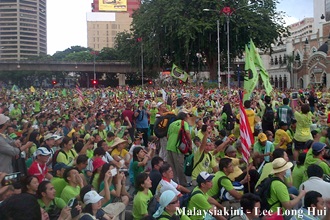 But there are also, I think, a significant number of thinking Malaysians who are not entirely convinced that the RM 1.3 billion Lynas factory (or Lamp - Lynas Advanced Materials Plant) is such a serious health hazard numerous government spokespersons including the health minister have argued.
But there are also, I think, a significant number of thinking Malaysians who are not entirely convinced that the RM 1.3 billion Lynas factory (or Lamp - Lynas Advanced Materials Plant) is such a serious health hazard numerous government spokespersons including the health minister have argued.
Lynas' proposed plant has been vetted by a number of Malaysian agencies including the Pahang state government, the Department of Environment and the Atomic Energy Licensing Board (AELB) and all of these agencies and bodies have approved the plans.
As the public still had reservations, the government then invited the International Atomic Energy Agency (IAEA) to come and do a study.
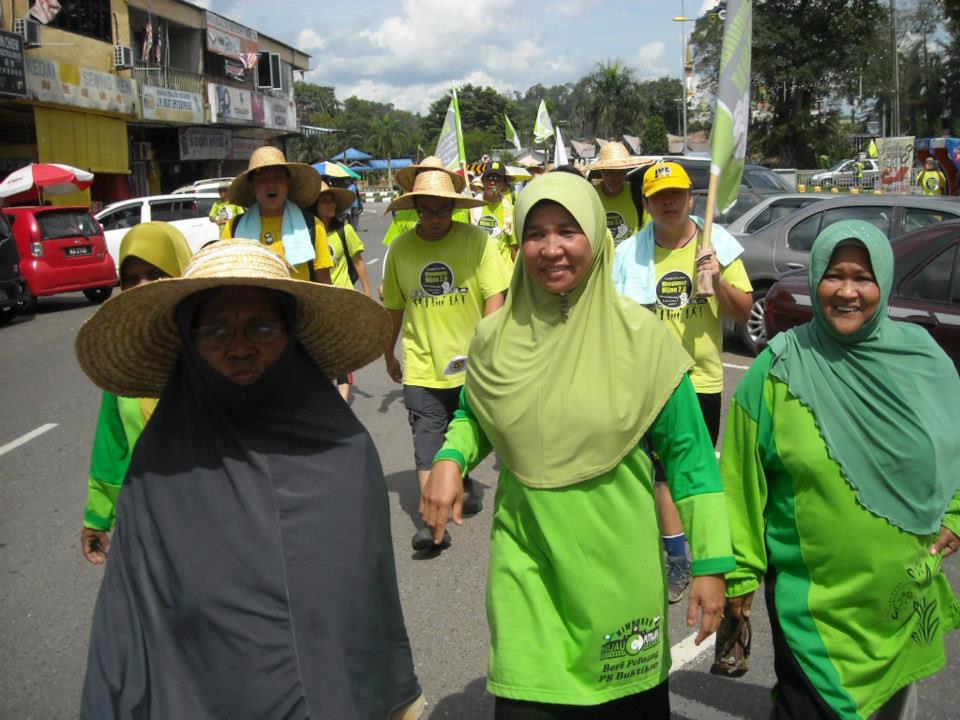 A nine-member team selected by the IAEA came on May 29, 2011 and after a study tour of six days declared the Lynas plant safe.
A nine-member team selected by the IAEA came on May 29, 2011 and after a study tour of six days declared the Lynas plant safe.
As people were still not satisfied, in March 2012, the government set up a special parliamentary committee to study the issue.
Three Pakatan Rakyat MPs were invited to sit on this nine-person committee but Pakatan decided to boycott this committee (as they felt that it was only a cover-up exercise with no mandate to actually veto the project).
This committee, too, made some recommendations but overall gave its endorsement for the project.
Based on all these, BN leaders have argued that the anti-Lynas protest has been fanned by opposition Pakatan leaders who are looking for issues to make the BN government look bad.
The people have been misled by scaremongers, they claim.
 Prime Minister Najib Abdul Razak (
right
) was quoted in
The Star
of Feb 27, 2012 as saying, "The Lynas Corp's rare earth plant in Gebeng has been reviewed by the government and found to be safe."
Prime Minister Najib Abdul Razak (
right
) was quoted in
The Star
of Feb 27, 2012 as saying, "The Lynas Corp's rare earth plant in Gebeng has been reviewed by the government and found to be safe."
He also said that they were looking for an uninhabited location to place the waste material from the Lynas plant.
"But if there are people who object for political reasons, there is nothing we can do about it. Opposition parties will look for issues like this as capital to garner support," he added.
I am one of the opposition MPs who, according to our PM, is a scare-monger. I have argued on several occasions in Parliament that the Lynas project be shelved.
But it has always been my belief that I should speak up for or against policies based on facts and principles, and not because of political expediency.
To espouse something which is not true or which you do not believe in, just to make you or your party popular amounts to misleading the public and reflects a lack of respect for the public!
I would now like to share with you the reasons why I have argued that Lynas should be shelved.
Vastly differing standards
First, a brief overview of the industrial process of separating the rare earths from the rest of the ore.
Lynas actually has the licence to operate a refining plant in Australia itself. Lynas acquired this licence upon buying over Aston, the company that owned the mine in Mount Weld.
In the mid-1990s, Ashton applied for a licence to refine the ore, and in the process of consultations with the public in the region, agreed to a set of specific performances.
If Lynas wants to use the refining licence that came with the purchase of Ashton, it is committed to observing all the procedures agreed to by Ashton earlier.
The table below compares requirements that Lynas would have to observe in Australia with the requirements for it in Malaysia:

The government has said in Parliament that Lynas is keen on operating a plant here because the total cost in Malaysia is only 30 percent of the cost of refining the ore in Australia. (Despite the fact that it has to be transported from Mount Weld to Freemantle Port, loaded on ships and then brought some 4,000km to Kuantan for refining.)
That means safety precautions in Malaysia are so much more lax than those required in Australia.
This point alone makes me uncomfortable. Why should we allow anything less in terms of safety standards than Australia?
Does the BN government feel that the Australian government is being too fussy? Or that Malaysians can take more radiation than the Australians?
Lynas' cavalier solid waste attitude
Let me quote verbatim from The Star Feb 10, 2012:
"Lynas Malaysia Sdn Bhd says that its residue from its rare earth plant in Kuantan will be safe and can be used to build roads. Its managing director Mashal Ahmad said that the firm had succeeded in lowering the radiation level to below 1 Becquerel per gramme, which is similar to the radiation level in fertiliser.
"He added that such usage of the residue was not new and common in developed countries. Mashal said if the residue could be used commercially, there would be no need to have a permanent disposal facility."
Rendered non-radioactive? How is that even possible? Thorium has an unstable nucleus.
Every year a small percentage of all Thorium existing in the world will start a process of nuclear decay, emitting a series of alpha, beta and gamma rays.
Out of every kilogramme of Thorium, about 10 billion Thorium atoms will start the process of decay each hour [1]. There is no known technology to stop this occurrence.
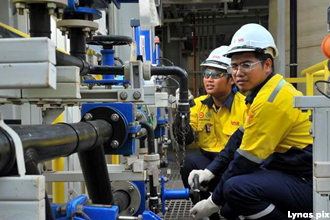 Lynas is trying to pull wool over our eyes. Let me explain - according to the IAEA, a substance is classified as radioactive if it emits alpha, beta or gamma rays at a frequency of equal to or more than 1 emission per second per gramme of that substance.
Lynas is trying to pull wool over our eyes. Let me explain - according to the IAEA, a substance is classified as radioactive if it emits alpha, beta or gamma rays at a frequency of equal to or more than 1 emission per second per gramme of that substance.
One radioactive ray per second per gramme is termed 1 Becquerel. One Becquerel per gram is the threshold level for classifying a substance as radioactive.
According to documents filed by Lynas, the solid waste from the Lynas refinery would have an emission level of 6.4 Becqueral per gramme. So it would have to be classified as radioactive.
But if one "dilutes" it by mixing this solid waste up with 9 parts of road fill material, then its radiation level drops to 0.64 Becquerel: Hey presto! No longer radioactive!
It is like adding water to a glass containing a sweet drink to make it taste less sweet but the total amount of sugar that is consumed is not reduced!
Don't forget, the same waste if produced in Australia would have to be shipped back to the mine and stored beneath the ground in the shafts from where it was taken.
We should also remember that the Lynas waste contains small but significant amounts of Thorium that has been ground down to a very fine size in the course of extracting the rare earths.
If roadworks are carried out on a road comprising Lynas manufactured road fill, or if a pothole develops, there is a real danger of this fine dust being into the environment. [2]
Underhand attempts to hoodwink us regarding the safety of the waste (and the amount of waste that will be produced is a huge amount - 64,000 tons per year [3]) has increased my level of suspicion regarding the entire project.
Integrity of ministries, agencies suspect
Our government's responses to the proposal to recycle the waste for commercial purposes isn't too reassuring either!
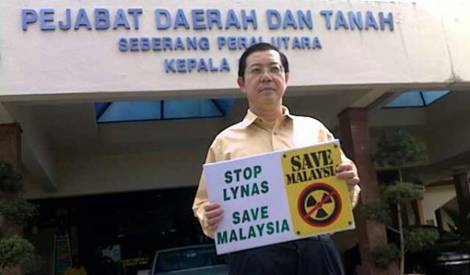 Consider the science, technology and innovation minister's reply on April 2, 2012 to YB Lim Guan Eng's (
left
) question in Parliament:
Consider the science, technology and innovation minister's reply on April 2, 2012 to YB Lim Guan Eng's (
left
) question in Parliament:
"Dakwaan YB Bagan bahawa syarikat Lynas tidak menjelaskan pelan pembuangan dan penyimpanan sisa projek Lamp adalah tidak benar. Syarikat Lynas bercadang mengitar dan mengguna semula residu yang dihasilkan melalui penyelidikan dan pembangunan untuk tujuan komercial . "
("The accusation by the honourable member from Bagan that Lynas hasn't yet specified how it intends to dispose of the waste from Lamp isn't true. Lynas has proposed that the waste could be recycled and deployed for other commercial purposes through R&D.")
This kind of answer does little to reassure thinking Malaysians genuinely worried about the possible health consequences of the Lynas Plant.
Are the government agencies competent enough? Do they understand the issues involved?
Do they know that if Lynas had set up its plant in Australia, it would have had to transport the solid waste back to the mine for storage?
Do they know about the issue of "internal emitters"? Or has Lynas influenced them by underhand methods?
Have certain parties already taken big sums of money promising to push the project approval through no matter what?
Once this element of doubt arises, and the credibility of the government agencies eroded, it becomes increasingly difficult to take their reassurances seriously.
But what about the IAEA?
They are supposed to be the international experts, and they have okayed the project. Right! But let me take you through a few points:
The IAEA is fully behind the drive to build nuclear reactors. They say that these are safe. That we have the technology to ensure that nothing goes wrong.
But we have had accidents in Sellafield (UK), the Three Mile Island (USA), Chernobyl (USSR), and this was the worst until Fukushima (Japan) occurred! How safe are they really? But the IAEA is still all for Malaysia embarking on building two nuclear reactors at a cost of more than RM20 billion! How objective is the IAEA?;
- Epidemiological studies have shown that the incidence of leukaemia in children staying within a 5km radius of nuclear reactors in Germany and in Britain is two times higher than the national average, although the levels of radiation in the 5 km radius are very much lower than the 1mSv/year "safe" threshold for the public as per IAEA recommendations [5];
- The British Parliament found this so disturbing that they set up a special committee the Cherie Committee - to study this increased incidence;
- The minority report of this committee posits that the health effect of exposure to low levels of radiation has been grossly underestimated by perhaps a factor of 100, because the effect of "internal emitters" has not been factored in [4]; and,
- A radioactive substance emitting alpha or beta rays will have negligible effect on any person in the vicinity as a few meters of air or clothes would stop these rays. But if a small part of that substance is inhaled or ingested and it then happens to release one of those rays that would be at point blank range and the odds that it causes significant damage to the DNA of that person is much, much higher.
We must remember that in the process of extracting the rare earths from the ore, the ore has to be crushed down to a very fine dust so that the economic product, the rare earths can be separated out. But crushing reduces the ore, including the Thorium content, to a very fine size, making ingestion and/or inhalation much more possible!
So, can we trust the IAEA as an objective authority its brief is to promote the use of nuclear technology the world over, especially to promote nuclear reactors! Lynas isn't a nuclear reactor to be sure, but if IAEA can be off the mark in the case of the adverse health effects of low level radiation in the vicinity of nuclear reactors, how much can we trust them when they say Lynas is safe.
There are people who argue that there has been "regulatory capture" of the IAEA by the multibillion Nuclear Reactor and Defense Industries!
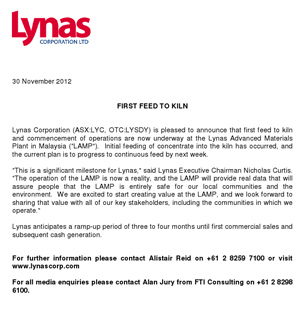 In any case, the IAEA team made 11 recommendations to ensure the safety of the Lynas Refinery, and one among these is that the manner in which solid waste will be managed should be submitted by Lynas and approved by AELB before Lynas is given approval to commence operation [5].
In any case, the IAEA team made 11 recommendations to ensure the safety of the Lynas Refinery, and one among these is that the manner in which solid waste will be managed should be submitted by Lynas and approved by AELB before Lynas is given approval to commence operation [5].
However the Temporary Operating Licence approved on July 2, 2012 allows Lynas to start operations even before they present their proposed plan for comprehensive management of the solid waste the TOL only requires them to submit the waste management plan within 10 months of starting operations [6].
Ten months have passed, and a safe permanent depository has yet to be identified and agreed upon by all parties. Instead Lynas is still talking of rendering the waste "safe".
"In a statement on Monday, Lynas said it would convert Lamp's water leach purification (WLP) residue which contains a low-level of naturally occurring radioactive material, into a commercially safe product called "synthetic aggregate". Lynas also said that the plant to convert the WLP had been built in Lamp and was now ready for operation." - The Star , Dec 12, 2012
IAEA assumptions off the mark
From information such as this I have come to the following conclusions:We still do not know the full health effects of low level radiation. The assumptions of the IAEA are obviously off the mark. They underestimate the adverse effects;
- The Lynas management has not been honest with us from the start. They have tried to bluff about health issues they kept the safety features that were required of them in Australia from us; they tried to make us believe that they could render the solid waste non-radioactive and therefore safe;
- The Lynas management were able to avoid a detailed environmental impact assessment (DEIA) before the project was approved because they managed to mislead our authorities that the material being refined was not radioactive they intended to ensure that the concentration of the ore sent to Malaysia didn't proceed to the extent that rendered the ore more radioactive than the 1 Becquerel per gram threshold; and,
- The Malaysian authorities are either very gullible or not terribly competent. Or else, they are on the take.
Given all the uncertainties, is it fair to expose the people of Kuantan to this rare earth refinery? I still am not 100% sure that it will definitely cause harm.
But can we take the risk and make the several thousands of Malaysians there the guinea pig s?
We should practice the "precautionary principle". If there is a risk that a particular course of action might bring adverse effects, then one should consider not embarking on that action unless there are very compelling reasons for doing so.
This is why I have argued several times in parliament that the Lynas Project should be shelved. And as there was an element of attempting to withhold information and mislead our government authorities by Lynas, the quantum of compensation should be modest if at all!
What do you think? Do you think that is being unreasonable?
JEYAKUMAR DEVARAJ is a PSM central committee member and MP for Sungai Siput.
Notes
1. Thorium, with 90 protons, is one of the largest atoms occurring naturally. However it's nucleus is not stable, and spontaneously undergoes degeneration by shooting out an alpha particle, thus transforming itself Radium (88 protons). Radium also is not stable, and it gives off a Beta particle transforming itself to Actinium (89 protons).
This process goes on over 10 steps until Lead (82 protons), an atom with a stable nucleus, is generated. In the process, 6 alpha particles and 4 Beta particles are shot out of the degenerating nuclei of a single Thorium atom.
You might be interested to know that there are 2.281 x 1024 atoms of Thorium in a kilogram of Thorium Oxide. As the half life of Thorium is 12 billion years, out of 1kg of Thorium, about 10 billion Thorium atoms will start the process of decay each hour!
2. As lead is the final product in the decay chain for Thorium, there will be a significant amount of lead in the solid waste. Lead can cause mental retardation in children if ingested by them. Lead dust in road mix would not add to the quality of our environment!
3. Let's calculate the amount of radioactivity that is going to be introduced into the country because of Lynas.
64,000 tonnes of WLP waste = 64,000 x 1000 kg = 64,000 x 1,000 x 1,000 grammes (64 x 109)
The radioactivity of the waste is said to be 6.4 Becquerels per gramme. Ie each gramme of that stuff will emit 6.4 radioactive rays every second. In other words 64,000 tonnes of waste will be emitting 6.4 x 64 x 109 radioactive rays each second.
Multiply that by 60sec x 60min x 24hr x 365 days and you will get a measure of the amount of radiation we will be introducing into our country for the year 12.9 billion radioactive emissions each year.
This amount of radiation from this year's waste will remain constant over the next several hundred years as the half life of Thorium is very long.
But every year another 64,000 tonnes of waste will be generated by Lynas which will contribute another 12.9 billion radioactive emissions per year! (It was all safely locked within the earth in Mount Weld, Australia! We are going to take it out, crush it into a fine powder, transport it around and then keep it in our backyard!)
4. Submission by Dr Chan Chee Khoon at the ministerial hearing on April 17, 2012 to revoke the TOL approved for the Lamp.
5. Written answer 306/June 2012 and 306/June 2012 to questions asked by YB Fuziah Salleh. Also The Star , Feb 23, 2012
6. The Star Feb 3, 2012. Pg 30. And The Star , Feb 23, 2012
Acknowledgements: Kuantan MP Fuziah Salleh , epidemiologist Dr Chan Chee Khoon , environmental activist Soo Jin Hou , and Kuantan residents V Vijayan and CS Yee who have all contributed information and analyses.




